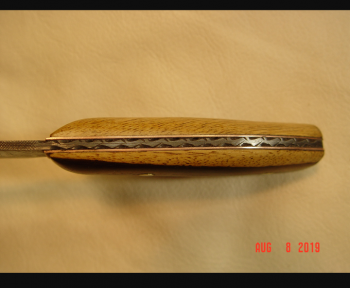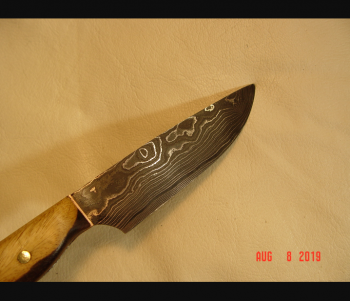Since others have brought it into play, and it appears that
@Bjmac has a good sense of humor and the appropriate open-mindedness, I'm guessing he won't mind mind if we look at his pictures a little closer.
Filework is the specific aspect I used in this thread so this knife might provide a good example. Lets look at the filework itself:
View attachment 69727
In my opinion, it isn't great....but it isn't the worst I've seen. It's pretty even and I can definitely see that he has the right file cuts in the right places for this pattern. In all honesty, he's only about another half hour of finishing/crisping file cuts away from taking this from mediocre to really good. That's pretty easily attainable.
So lets assume the next time the filework is really good. There are still some areas on this knife that would distract from and nullify even really good filework, in my opinion.
View attachment 69728
In the previous pic and this one, we can see and it has been mentioned by others, that there are some issues with the fit of the scales/liners to the tang and also some fit issues with the copper liners to the scales themselves. But also, in this pic I can see that the butt ends of the scales themselves are both different thicknesses and shaped with different radii. This is telling me the handle scales are asymetric side to side.
In the previous pic, it also looks like the scales are uneven side to side. And it looks like the pin is not flush with the scales and sharp edges of it are exposed.
View attachment 69729
In this pic, I can't see the whole knife so handle shape and overall flow/proportions can't be accurately assessed but I like the blade shape quite well and there is a nice visually pleasing radius leading from the end of the handle into the heel of the blade.
The copper liner appears longer than the scale which I find visually distracting. The finish on the blade itself seems gritty, muddy and washed out looking but there could be several factors at play there and without more info I couldn't comment on how to remedy that.
So in summary, this knife to me is a good example of the original post where I personally would have liked to see some of the fit and finish issues addressed before moving on to filework. This is a case where even really good filework doesn't overcome the other mentioned issues.
Sometimes mistakes are easy to fix and sometimes its actually far easier to throw it in the scrap drawer (I have one) and start over. If I get thinking about how to and how long it takes to fix all the mistakes and it starts to feel daunting, its usually time to start over. Or at least pop the scales off, fix the blade if necessary/possible and redo the handle.
@Bjmac....I appreciate your volunteering your pics up and your sense of humor and thick skin. You have some skills and if there is anything you like about my knives or my style and there is anything I can do to help you out, please do not hesitate to reach out.




